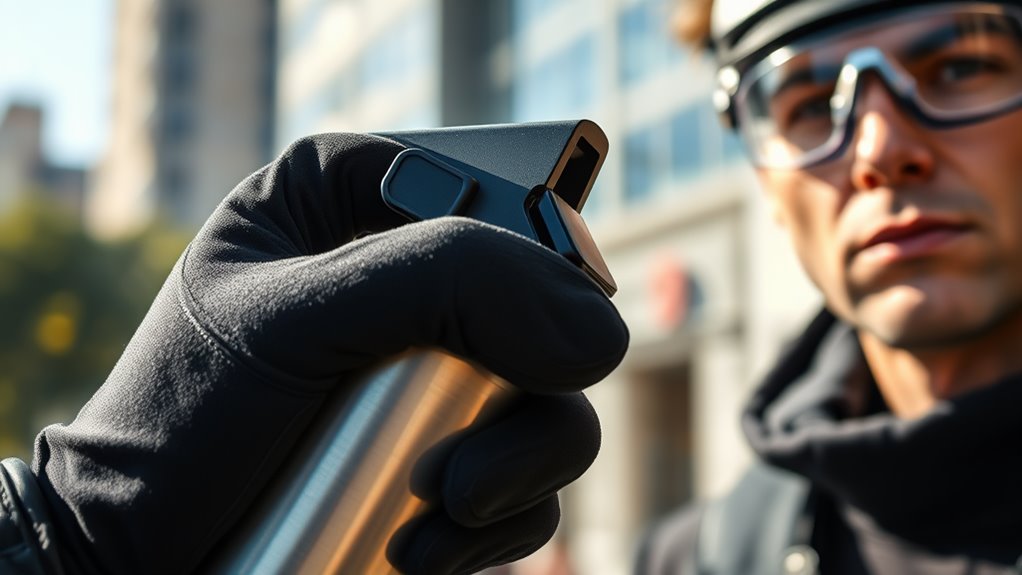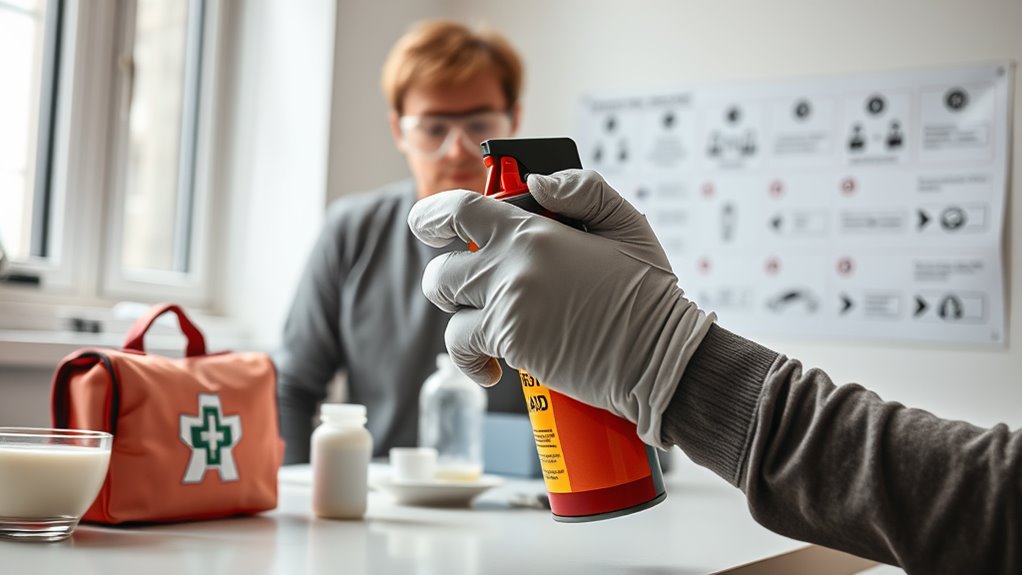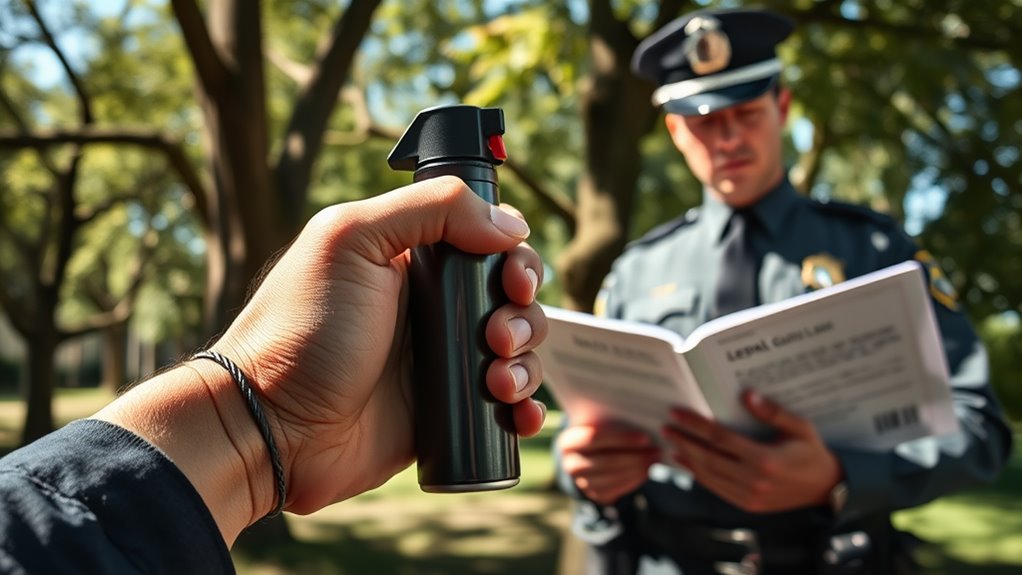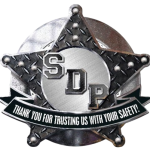Faced with an emergency, handling pepper spray requires precision and calm. Confirm you're 4 to 10 feet from the target, and aim for the attacker's eyes using short bursts. Be mindful of the wind to avoid self-exposure. Store pepper spray cool and dry, and regularly check its expiration date. If exposed, move to an airy spot, wash skin with cool water, and flush eyes with saline for 15 minutes. Always know local laws to avoid legal issues. Mastering these steps confirms you're effective in a crisis while staying safe. A deeper dive will provide further insights.
Understanding Pepper Spray Effects

When you're exposed to pepper spray, understanding its effects can help you respond quickly and effectively. Pepper spray, known for its incapacitating power, stems from its active ingredient: oleoresin capsicum. This natural oil, extracted from hot peppers, gives the spray its fiery kick. The pepper spray composition is designed to target the eyes, respiratory system, and skin, causing an immediate physiological response.
As soon as it contacts your skin or eyes, you'll notice a burning sensation. This is because the oleoresin capsicum causes inflammation, which is your body's natural reaction. Your eyes might start tearing excessively, making it difficult to see. Blinking becomes almost impossible, and temporary blindness could occur. This is your body's way of protecting itself, trying to flush out the irritant.
Breathing will also become challenging. The spray irritates your respiratory system, leading to coughing, a runny nose, and difficulty breathing. Your throat might feel like it's constricting, which can be alarming but is typically temporary. This physiological response is meant to subdue, not harm permanently.
On the skin, expect a stinging or burning sensation, akin to touching a hot surface. This discomfort is part of the body's inflammatory response, and while it's intense, it usually subsides within an hour or so.
The effective range of certain pepper sprays, like the WildFire 1.4% Crowd Control 1 Pound Pistol Grip Fogger Pepper Spray, can reach up to 20 feet, allowing for a safer distance during crowd management situations.
Proper Deployment Techniques
Understanding the effects of pepper spray is just one part of the equation; knowing how to deploy it properly can make all the difference in an emergency. When faced with a threatening situation, your response time and technique are vital. Start by maintaining an adequate deployment distance. You should aim to be within 4 to 10 feet of the target for maximum effectiveness. Too close, and you risk blowback, too far, and the spray might dissipate before reaching the assailant.
Always consider the wind direction. Deploying pepper spray with the wind at your back will carry the pepper particles more effectively toward your target. If the wind is blowing towards you, reposition yourself quickly to avoid the spray blowing back into your face. This isn't just about effectiveness; it's also about your safety. The Mace Brand Pepper Gun 2.0 can help maintain a safe distance with its effective range up to 20 feet.
Grip the canister firmly in your dominant hand with your thumb resting on the actuator. This grip guarantees you're ready to spray without fumbling. When you're ready to deploy, aim for the attacker's face, specifically targeting the eyes for maximum impact. Use short, controlled bursts, moving the canister from side to side to create a wide swath. This increases the likelihood of contact even if the target tries to dodge.
It's important to be aware of laws & restrictions regarding self-defense products in your area to ensure legal compliance. Practice these techniques regularly in a safe environment to build muscle memory. The more comfortable you're with the deployment process, the more effectively you can protect yourself in high-stress situations.
Safe Handling Practices

Handling pepper spray safely is essential to prevent accidental discharge and guarantee it's ready for use in emergencies. First, always verify you're storing your pepper spray in a cool, dry place. Extreme temperatures can affect the pressure inside the canister, potentially causing it to leak or become less effective. A drawer or a cabinet away from direct sunlight is ideal. Use a protective case if you're carrying it in a bag to avoid any accidental activation. The compact design of the pepper spray allows for easy carrying and discreet storage, making it convenient for everyday use. When it comes to maintenance tips, regularly check the expiration date on your pepper spray. Most canisters have a shelf life of about three to four years, but it's a good idea to test it periodically. Do this by spraying a small amount outdoors in a safe area, ensuring that the wind is blowing away from you. This not only confirms that it's functioning correctly but also helps you familiarize yourself with its range and spray pattern. Make sure that the safety mechanism is always engaged when you're not using the pepper spray. This prevents accidental discharge, which could harm you or someone else nearby. Additionally, practice removing the safety cover smoothly, so you're not fumbling during an actual emergency. The UV dye included in some pepper sprays can aid in investigation and identification if needed. Lastly, remember to keep the pepper spray out of reach of children and pets. Even with the safety engaged, it's best to eliminate any risk of accidental exposure.
Decontamination Procedures
Dealing with pepper spray exposure requires prompt and effective decontamination to alleviate discomfort and prevent further irritation.
Start by moving to a well-ventilated area to reduce inhalation effects. Fresh air is essential in clearing the airways and minimizing the impact of pepper spray on your respiratory system.
Next, focus on decontamination methods for your skin. Begin by flushing the affected areas with cool water. Don't rub the skin, as this could intensify the burning sensation. Instead, let the water run over your skin to gently remove the irritants.
If available, use a mild soap to help break down the oils in the spray, but be sure you're rinsing thoroughly. Avoid using harsh soaps or scrubbing agents, as they might worsen the irritation.
For skin relief, consider applying a cold compress to the affected areas. This can help soothe the burning sensation and reduce inflammation. Additionally, you might use a gentle moisturizer or aloe vera gel to further calm the skin after thoroughly rinsing it.
Take care not to apply anything before the pepper spray is fully washed off, as it could trap the irritant on your skin.
If your eyes are affected, flush them with clean, cold water or saline solution for at least 15 minutes. Avoid rubbing your eyes, as this can cause further damage.
Blink frequently to help clear the spray from your eyes naturally.
Legal Considerations and Guidelines

While managing the physical effects of pepper spray is important, knowing the legal considerations surrounding its use is just as significant. Before you even think about carrying or using pepper spray, understanding the legal ramifications can save you from unnecessary trouble.
Different regions have their own laws regarding the possession and use of pepper spray, and violating these can lead to fines or even criminal charges. It's essential to familiarize yourself with local laws to guarantee you're compliant and to avoid any unintended legal consequences.
You should also be aware of usage restrictions that might apply. Some areas may limit the pepper spray's strength or the size of the container you can carry. Others might require permits or registration for carrying pepper spray. Ignoring these restrictions could result in serious penalties.
Always check with local authorities or legal resources to confirm what's allowed in your area. This due diligence not only keeps you within the law but also informs you of any actions you might need to take, such as attending training sessions or obtaining specific permissions.
If you're planning to travel, remember that legal considerations can change drastically between regions. What's legal in one place might be prohibited in another. Staying informed about these variations is crucial to preventing legal issues.
Frequently Asked Questions
How Should I Communicate With Bystanders After a Pepper Spray Incident?
Calmly address bystander reactions, ensuring effective communication. Quickly explain the situation, reassure their safety, and guide them to a safe area. Use clear, concise instructions to prevent panic and maintain order. Keep your tone composed and authoritative.
What First Aid Supplies Should I Have on Hand for Pepper Spray Exposure?
For first aid after pepper spray exposure, you should have eye wash, saline solution, and clean cloths. Keep a water bottle handy for rinsing and make certain you've got gloves to protect yourself while assisting others.
Are There Alternative Self-Defense Tools to Consider if Pepper Spray Isn't an Option?
Imagine a knight without a sword; sometimes you need alternatives. Consider self-defense techniques like Krav Maga for agility. Personal safety gadgets like alarms or tactical pens offer protection. They're your modern-day shield, enhancing your safety arsenal.
How Do I Safely Dispose of Expired or Unused Pepper Spray Canisters?
To safely dispose of expired or unused pepper spray, take it to a hazardous waste facility. Don't just throw it away; improper disposal harms the environment. Always prioritize safe disposal to reduce environmental impact.
What Steps Can I Take to Mentally Prepare for Using Pepper Spray in an Emergency?
To mentally prepare for using pepper spray, practice situational awareness regularly. Visualize potential scenarios, focus on staying calm, and rehearse your response. Confidence and mental readiness can greatly enhance your ability to react effectively in emergencies.
Conclusion
In an emergency, handling pepper spray is like wielding a double-edged sword—powerful but requiring careful control. You've learned its effects, proper deployment, and safe handling, ensuring you're ready to act responsibly. Remember to follow decontamination procedures to minimize harm and always stay within legal boundaries. With these tools, you can protect yourself and others effectively, turning a potentially chaotic situation into a manageable one with confidence and precision.




